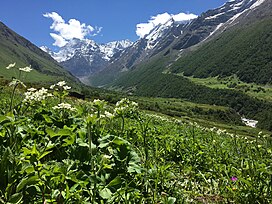Western Himalayan alpine shrub and meadows
| Western Himalayan alpine shrub and meadows | |
|---|---|
 | |
| Ecology | |
| Realm | Palearctic |
| Biome | Montane grasslands and shrublands |
| Borders | List |
| Bird species | 389[1] |
| Mammal species | 61[1] |
| Geography | |
| Area | 70,200 km2 (27,100 sq mi) |
| Countries | |
| Conservation | |
| Habitat loss | 17.291%[1] |
| Protected | 19.18%[1] |
The Western Himalayan alpine shrub and meadows is a
Setting
The Western Himalayan alpine shrub and meadows covers an area of 70,200 square kilometres (27,100 sq mi), extending from the
The
Flora
Alpine shrublands, dominated by rhododendrons, predominate at lower elevations close to the treeline.
Above the shrublands are alpine meadows, known as
On the upper slopes, low plants of genera Saxifraga, Allium, Corydalis, Eriophyton, Stellaria, Soroseris, and Cremanthodium grow among the boulders and scree.
An alpine steppe of Caragana pygma, C. gerardiana, Lonicera spinosa, Juniperus squamata, Juniperus indica, Ephedra gerardiana, Hippophae tibetana, Myricaria rosea, Lonicera spinulosa, and Berberis can be found in drier parts of the ecoregion.
Fauna
Large mammals include the
Conservation
Several protected areas lie within or partly within the ecoregion, including:
- Royal Dhorpatan Hunting Reserve (Nepal)
- Govind Pashu Vihar Wildlife Sanctuary(Uttarakhand, India)
- Lippa Asrang Wildlife Sanctuary (Himachal Pradesh, India)
- Sangla Wildlife Sanctuary (Raksham Chitkul) (Himachal Pradesh, India)
- Gangotri National Park (Uttarakhand, India)
- Kedarnath Wild Life Sanctuary(Uttarakhand, India)
- Valley of Flowers National Park (Uttarakhand, India)
- Nanda Devi National Park (Uttarakhand, India)
- Shey-Phoksundo National Park(Nepal)
- Annapurna Conservation Area (Nepal)
See also
References
- ^ a b c d
Hoekstra, J. M.; Molnar, J. L.; Jennings, M.; Revenga, C.; Spalding, M. D.; Boucher, T. M.; Robertson, J. C.; Heibel, T. J.; Ellison, K. (2010). Molnar, J. L. (ed.). The Atlas of Global Conservation: Changes, Challenges, and Opportunities to Make a Difference. ISBN 978-0-520-26256-0.
- "Western Himalayan alpine shrub and meadows". Terrestrial Ecoregions. World Wildlife Fund.
- World Wildlife Fund, ed. (2001). "Western Himalayan alpine shrub and meadows". WildWorld Ecoregion Profile. National Geographic Society. Archived from the original on 2010-03-08.
